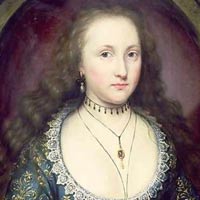Love, a Child is Ever Crying by Lady Mary Wroth: Summary and Analysis
This poem is an extract from a sonnet sequence Pamphilia to Amphilanthus. Pamphilia, a lady, is trying to give an advice to a man named Amphilanthus that love should be controlled. The poem has a very regular rhyming structure of five quatrains with an aabb rhyme scheme.

Lady Mary Wroth (1587-1651)
In the poem, Love, a Child is Ever Crying Wroth’s speaker is speaking to a man about the nature of love which is personified as a demanding child. The image of love as naughty child is common and relates in part to Cupid. As a strong-willed child there is simply no pleasing him: fulfill his one need and he will be back with another as in the poem the line goes "Give him, he the more craving". The love like a willful child is not happy with the things in possession. The poet goes on comparing other attributes of a haughty child with the love: he breaks his promises, even the vows he makes are false, he flatters, and he can even leave his beloved, and can deceive you. At the same time, the speaker compares the lovers with cupid. Lines like "he straight is flying", "Endless folly is his treasure," make the analogy. Cupid is winged because lovers are flighty and likely to change their minds, and youthful because love is foolish and irrational. His symbols are the arrow and torch, because love wounds and inflames the heart. Sleeping Cupid is a symbol of absent or suffering love. Cupid is also often depicted blindfolded and described as blind, not so much in the sense of sightless - since the sight of the beloved can be a spur to love - as blinkered and arbitrary.
The poem does not have an innocent opinion about love, but rather a torturing nature. The poet is of the view that if unnecessary demand of love is not controlled on time, something disastrous will certainly happen. The poet suggests that in such case the best option is to leave the crying baby, which metaphorically means leave the love of life for the sake of own peace of mind.
The poem is also the first extended portrait of a personified love by a woman author in English. In addition, the lady speaker is seen consciously searching for her own identity, which she perceives as being apart from the men in the lives. Mary Wroth's poetry is similar to Dorothy Parker's in that both women can distance themselves from love and comment on the absurdity of it. Both were urban sophisticates who were in and out of love affairs and marriages. These women had intelligence and self-knowledge that let them stand back from the turmoil of their emotional lives and comment with wit and insight. There is a sly humor in their poetry coupled with an element of truth.
